
The best portable Bluetooth speakers of 2021
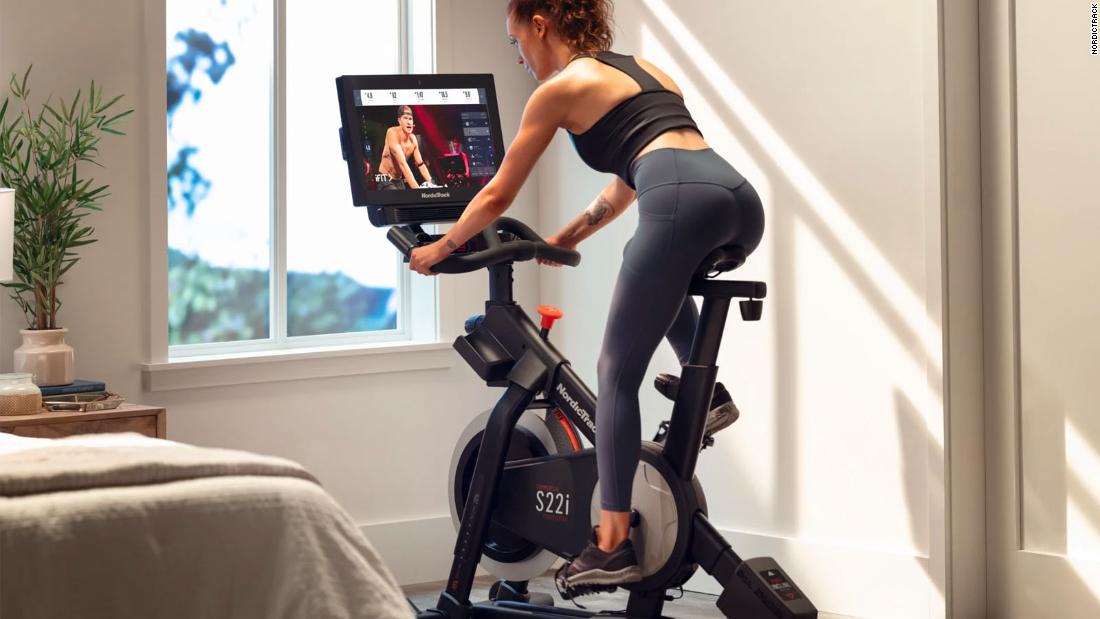
CNN —
A great portable speaker is more than just roadworthy — it needs to sound pretty damn good wherever you go. Whether you’re listening quietly while catching up on summer reading or getting the party started, it needs to put out clear and crisp audio, with enough battery life to make it through the day.
To make your path to purchasing easier, we’ve spent the past month testing 18 speakers to find the best for your needs and budget. After countless tests and many hours spent rocking out to a lot of great music, we’ve found four speakers that rose to the top.
Best all around portable speaker
The UE Boom 3 gives you robust, 360-degree sound in a waterproof, dustproof canister that you can take everywhere. It’s pretty much everything you could want in a Bluetooth speaker for $149.99.
Best travel pick
Sony’s XB13 is the first piece of tech we’d throw in our bag this summer. This compact speaker pushes out sound much larger than its size, and the built-in cloth strap lets you securely attach it to a backpack, bike handlebars, or anywhere you want music.
Upgrade pick
The Sonos Roam is both a super-portable Bluetooth speaker and a full-featured Sonos satellite, so it fits into your home multi-speaker setup and lets you bring your music on the go. As you’d expect from Sonos, it delivers strong sound quality and plenty of adjustability.
Budget pick
The Tribit Stormbox Micro is a near-perfect speaker for its $50 price. It’s unassuming square build features a strong rubber strap on that back for easy attachment anywhere and the battery gives you eight hours of playback. Sound quality is surprisingly good for the small size.

Jacob Krol/CNN
UE Boom 3
From strong sound to long battery life, the UE Boom 3 checks off all the boxes. Housed in a cylindrical canister just over 7-inches tall it’s small enough to take with you (about the size of a water bottle) but puts out enough high-quality sound for almost any situation.
You can customize the Boom 3 in hundreds of color and design combinations. From hot pink with purple accents to a muted lavender (like the Boom 3 we’ve been testing) you’re sure to be able to match your tastes. A small cloth hook on the rear lets you hang the Boom 3 on hook or clip a carabiner in. The bottom has a standard tripod thread if you want to mount the Boom 3. And on the rear, under a waterproof rubber door, is a micro USB port for charging. This is outdated at this point, and one of the Boom 3’s few downsides. A wireless charging dock is available separately, but we’d prefer an up-to-date connector here too. Please Ultimate Ears, switch it to USB-C.
The Boom 3 has an IP67 rating, meaning it’s dustproof and can handle being immersed in water up to 1 meter deep for 30 minutes. You wouldn’t want to take it snorkeling, but it can withstand splashes, make it through any hike or camping trip and take a dip in the pool.
Using the Boom 3 is as simple as its visual design. Two large, easy-to-press volume controls are on the front, with all other controls accessed via two buttons at the top. The smaller button at the top turns the Boom 3 on or off — and we love the quick bongo beat when you turn it on. It’s a taste of the sound quality to come. The more prominent button (UE calls it the “Magic” button), controls all other functions. A single push will play or pass. A triple tap skips and long-press resumes playback to a preset playlist. Via the Boom & Megaboom app for Android or iOS, you can choose that playlist from Amazon Music, Apple Music or Deezer. It’s a fun feature, but not a necessary one.
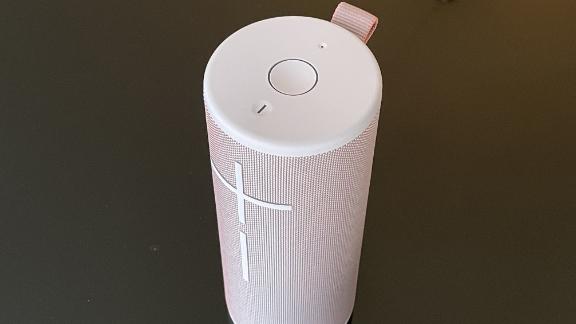
Jacob Krol/CNN
Connecting the Boom 3 to Bluetooth took a matter of seconds with an Android or iPhone. After that we hit play on “Good 4 U” by Olivia Rodrigo to hear the smooth opening bass line, her vocals were clear before the instrumental track built into a loud clash of a climax. Boom 3 offers clear separation between instruments and we only heard any distortion with a lower quality track at super-high volumes. It’s impressively clear sound from a speaker this small. And the Boom 3 gets quite loud — at 50% we could easily fill a small room in an apartment and 100% let’s us hear it throughout the space. It pushes sounds out in a 360-degree format, so you can put it anywhere and still get good sound.. And it’s not just good for pop-punk, a track like “Fire” by Bruce Springsteen displays how the Boom 3 can tackle a more subtle mix — we could easily distinguish the opening bass and guitar tones before Springsteen’s vocal, drums and piano enter. If you want a stronger sound you can easily pair or group the Boom 3 with any other UE speaker.
For moments when you want to increase the bass or any aspect of the mix, the Boom & Megaboom app will be your best friend. And it’s an aspect that let the Boom 3 stand out from the plethora of speakers we tested. You get a full equalizer to play with and customize on the fly. UE offers a few presets like “cramped spaces” or “voices” and leaves you with one “custom” mode that will save your selections. We just wish you could save multiple EQ mixes.
It’s disappointing that the Boom 3 charges with micro USB, but you won’t need to grab the included cord that often. In our testing, the Boom 3 lasted for a substantial 14 hours at 60% volume. Quite impressive for a speaker of this size. The UE Boom 3 lasted longer than other speakers that were closer to the $200 price point.
At $149.99 the Boom 3 gives us what we’re looking for in a Bluetooth portable speaker and we have no doubt it will be blasting tunes for a long long time.
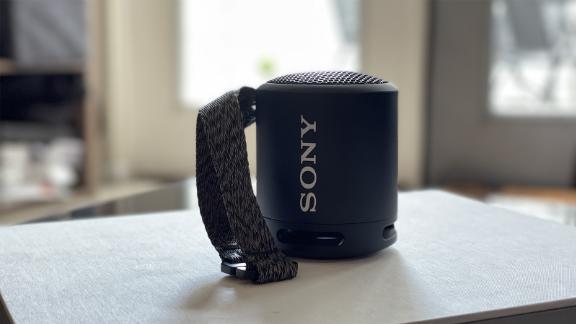
Jacob Krol/CNN
Sony XB13
If we could pick one piece of tech to bring with us on the road this summer, without question it would be the Sony XB13. This fist-sized speaker punches far above its weight with rich and crisp sound in a package that wants to go with you.
The Sony XB13 is really compact at just over 4-inches tall and weighs in at half a pound, lighter than some phones.A cloth strap lets you attach the speaker to a backpack, tote bag, or suitcase, and makes it easy to carry on its own all day, which we did repeatedly on train and car trips. A rubber grip on the bottom ensures the XB13 won’t move or topple over with bass-heavy tracks, and it’s IPX7 rated, meaning it can survive for as long as 30 minutes in up to a meter of water (Sony doesn’t give a dust protection rating, so your mileage may vary for desert camping).
You get your pick of black, taupe, navy blue, pinkish-orange and powder blue finishes. The speaker is mounted facing the top of the unit, while a passive radiator dispenses bass tones from the bottom of the case. Despite the XB13’s small size, it can fill smaller rooms — like a bathroom — with relative ease. In fact, if you’re looking for a speaker to accompany your singing in the shower the XB13 certainly made our vocals sound better. The XB13 offers clear and rich sound that lets you hear all aspects of a song. “Good 4 U” by Olivia Rodrigo sounded full, “Fire” by Bruce Springsteen offered a precise mix and “What’s Going On” by Marvin Gaye reassured us that the XB13 could handle a range of tones at varying volumes without apparent distortion. Even at 100% volume, low-mid-high tones came across clearly with no added crackling. For bigger sound, you can sync multiple XB13s in party mode.
The XB13 is a seriously long-lasting speaker, lasting a full 15 hours in our battery test. That’s just 30 minutes of Sony’s promised 16 hours and means the XB13 is the longest-lasting speaker out of any of our top picks. That also doubles down on the fact that it is perfect for traveling.
You can enable Bluetooth pairing by turning the XB13 on and then holding in the Bluetooth button for a second or two. After that, connect to it from your device and you’re set. All of the on-device controls are housed in a rubber strip. It’s a very tactile experience and makes it easy to find the buttons without looking. Behind a rubber door, you’ll find the USB-C port. Lastly, the XB13 has built-in microphones which lets you use it for speakerphone. It’s louder than an iPhone, Google Pixel or Samsung Galaxy and lets those on with us hear us clearly on cellular or VoIP calls.
For $59.99, the Sony XB13 is a great ultra portable Bluetooth speaker. It might not get as loud as our other picks, but it offers rich sound and extremely long battery life in a super portable size.

Jacob Krol/CNN
Here’s the best thing about the Sonos Roam — it’s not just your average portable speaker with Bluetooth connectivity; it’s a full-featured Sonos speaker that integrates with the broader Sonos ecosystem and can be used with all of the other Sonos devices in your home setup. And rest assured, it does indeed sound like a Sonos.
It resembles the UE Boom 3, our overall pick, standing about 7-inches tall, though a bit more of a triangular prism in profile. Roam is available in Shadow White or Lunar Black. Like the UE Boom 3 and Sony XB13, the Roam is an IP67 rated speaker, so it can survive a dip in the pool. A UV coating means you can leave it out in the sun without the finish cracking.
Unlike the Boom, its drivers face front, so it doesn’t feature 360-degree sound coverage, but you can use it vertically or horizontally. Four foot-like bumps in the body on one side make it easy to rest securely in landscape mode.
Core controls — microphone, volume down, play/pause, volume up — live on the top while a power button and USB-C port for charging live on the back. You can also charge the Roam by placing it on any Qi-wireless charger. Sonos also sells a charger that doubles as a stand for $49.99. In our testing, the Sonos Roam lasted for 10 hours and can stretch over multiple days with standby. It’s refreshing, especially at this price point with this many features.
To set up the Roam, you’ll need to download the Sonos app and sign in with an account or create one (the account is free, though some of the services require paid subscriptions). Turn the Roam on, and you’ll get a prompt in the app to set up the Roam. You’ll either scan it via NFC on your phone or have it listen for a tone. That will complete the pairing and you’ll be ready to go. Like any other Sonos speaker, when you’re at home, it will primarily use Wi-Fi, or you can use AirPlay if you’re streaming from an Apple device . You can use the Sonos app to pick music from hundreds of services (Spotify, Apple Music, Sirius XM, Pandora and Sonos Radio included) or can even use an assistant to ask for music. The Roam features microphones which let you use Amazon Alexa or the Google Assistant.
You can only use the Sonos app’s nifty features like universal search across different platforms while you are connected to your home Wi-Fi network. On the go, the Roam functions like any other Bluetooth speaker (or via AirPlay if you are connecting from an iPhone or iPad). You can still stream content from a variety of services, but you’ll be using the individual apps for each over LTE or 5G.
That said, Bluetooth pairing is simple (you enable it by holding in the power button). We had no connectivity issues with Bluetooth and, similarly, none when using Wi-Fi. We’d also call out that Roam had a wide range of Wi-Fi connectivity. It worked deep into our backyard and out on a patio.

Jacob Krol/CNN
We have no doubt you will be impressed by the Roam’s rich sound, which helped make it our upgrade pick, wide range of services aside. Roam can bring any track to life while also getting seriously loud. At 60% volume, it could fill several rooms in our apartment and at 100%, it could be heard outside in the hallway with the door closed. Audio doesn’t distort either — “Born to Run” by Bruce Springsteen with its wall of sound effect held up strong, letting us hear drums, saxophone, guitar, piano and vocals all without swirling together. Similarly, “Good 4 u” by Olivia Rodrigo came through with forceful sound from the electronic beats to Rodrigo’s vocals.
You can also use the Sonos app to customize the mix via an equalizer, or you can depend on TruePlay, which uses the onboard microphones to adjust EQ to compensate for your listening environment.
For $169.99, the Sonos Roam packs some serious value and stretches farther with functionality than other speakers we tested. It can be a smart speaker, integrate fully into an ecosystem of speakers, and act as a Bluetooth speaker effortlessly.
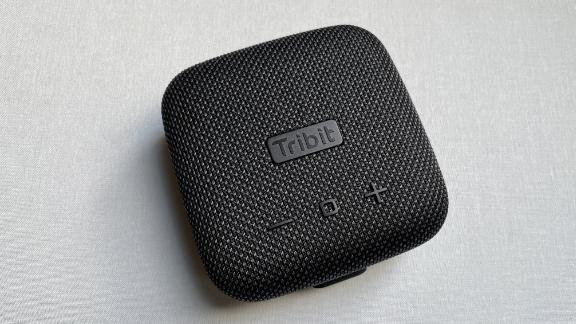
Jacob Krol/CNN
If you want to spend under $50 on a portable speaker, look no further than the Tribit Stormbox Micro. You might imagine that it cuts out some fancy features for the price, but it’s a speaker that can stand up to the others we’ve tested.
The unassuming square speaker features a built-in rubber strap that you can use to attach it securely to a bike, backpack, tote bag or an article of clothing. This type of attachment is common on our pricier picks and on other speakers we like such as the Bose SoundLink Micro, but here you get it for way less. The Stormbox Micro is available in a simple black or a feisty orange. And if you’re cycling in the rain or just caught outside in some bad weather, the Stormbox Micro carries an IP67 rating which means it can handle splashes, immersion, or dusty environments.
Sound quality was surprisingly good for a $49.99 speaker as it sounds as rich and clear as some of the higher-priced options we tested. “Born to Run,” “Good 4 u,” and “Free Bird” by Lynyrd Skynyrd all were enjoyable. Bass isn’t over-emphasized nor are vocals or midrange instruments — it’s very balanced sounding for such a small unit.. It also gets seriously loud, nearly matching the UE Boom 3 at full volume, but we did hear some distortion at high volume. If you want more coverage, you can sync with a second Stormbox Micro, as with our more expensive picks
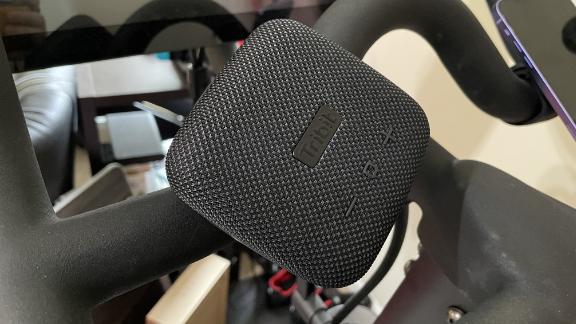
Jacob Krol/CNN
The Stormbox Micro was easy to connect to via Bluetooth and we didn’t encounter any dropouts in connectivity. You power the speaker on, enter pairing mode and connect from your device. It’s as simple as that. You can control playback from the paired device or from the controls on the top of this speaker. You’ll find volume down, play/pause and volume up buttons center. On the black variant, these buttons can be hard to see in low light. There’s an LED indicator for battery level along with a power and pairing button on the front.
The right side has a USB-C port for charging and it’s refreshing to see the latest port standard on a budget speaker. We hit a total eight hours of music playback at our test listening volume across various genres in our testing. Tribit includes a USB-C cable in the box for easy charging.
For the price, you really can’t do much better than the Tribit Stormbox Micro. Sure we’d like some more color options, but it’s a near-perfect speaker for $49.99 (and it’s frequently on sale for less).
After deciding on our testing pool and all of the portable speakers arriving, we began our testing. To test sound equally across all the devices, we used an external microphone and dB meter to measure and balance the output level across all the speakers.
After we established the base level, we tested sound and examined audio quality across various tracks. We used songs from several genres like pop, rock, hip-hop, punk, and classical. We paid close attention to the overall sound quality and if the speakers introduced any distortion or muddiness to the track.
We fully charged all of the speakers and ran playback at 60% until the speakers died out to test for battery life. This way, we could have a baseline for sound output and test for how long the speakers lasted. If the device offered quick charging, we timed how long it would take to reach a certain percentage of power. We also noted the power draw from the wall brick.
We tested all the speakers’ usability and functionality by using the onboard controls, pairing them with apps (when applicable), and testing all features. The latter included stereo pairing or specific sound boost modes. We tested its durability by hanging it from several items if there was a built-in hook, carabiner, or strap. Similarly, we tested the speakers with a hose in the bathtub or in dirt to test water or dust resistance.
Lastly, we took into account the length of the warranty and what was covered for each speaker.
Anker Soundcore Flare Mini ($49.99; amazon.com)
For the same price as the Stormbox Micro, the Soundcare Flare Mini puts an emphasis on aesthetics with a rainbow lightstrip on the bottom. It’s a neat party trick but feels like a gimmick as the sound quality is a bit middling.
Anker Soundcore Flare+ ($99.99; amazon.com)
The Soundcore Flare+ corrects the mistakes of it’s smaller sized sibling with rich sound that can get quite loud. It also lasts for 18 hours, even with the bottom light strip going. Similar to the 4th Gen Echo, the light will reflect off the surface it is on.
Bose SoundLink Micro ($99.99; bose.com)
This portable speaker from Bose is quite similar to the Tribit Stormbox Micro. It has a square build with a built-in strap on the back that makes it easy to attach to anything. Sound quality was classic Bose with a balanced sound across all frequency ranges, but it can’t bee customized through an equalizer. We think you’ll find a lot more value in our budget pick.
Bose Revolve II ($199.99; bose.com)
Bose’s mid-range Bluetooth speaker, the Revolve II, is dramatically bigger than the SoundLink Micro, but slightlyy smaller than the UE Boom 3 or Sonos Boom. It’s a triangular cyclendrical build with machined holes in a 360-fashion on the lower part and sealed sides approaching the top.
Bose Revolve+ II ($299.99; bose.com)
The Revolve+ II is a really nice bluetooth speaker with a nice handle for portability. It’s got the classic Bose sound, providing a balanced experience that can get pretty loud for the unit’s size. We also didn’t encounter any distortion, but the price doesn’t get you any features that make it stand out over our top picks.
EarFun UBoom ($49.99; amazon.com)
EarFun impressed us in the past with earbuds and for $50 they make an all around good Bluetooth speaker. It has a similar design to other basic models, with a vertical design that includes a rubber grip bottom for stability. It had good sound but for the same price, you get richer sound and more functionally from the Tribit Stormbox Micro.
JBL Clip 4 ($69.95; amazon.com)
The Clip 4 is designed to go with you, or clip onto something like a bag or backpack with its sturdy carabiner. The Clip 4 comes in a number of colors. It didn’t deliver a much more impactful experience over the Stormbox Micro though, which is cheaper.
JBL Charge 5 ($179.95; jbl.com)
The updated Charge 5 is really similar to the Charge 4 and for the same price it can get louder and the battery lasts longer. You’re better off purchasing the Charge 5 over the 4 for the better sound and if you really want a speaker that can charge another device.
JBL Charge 4 ($149.95, originally $179.95; jbl.com)
For close to $180 at full retail, the JBL Charge 4 is a solid but expensive Bluetooth speaker. We found sound quality to be in the middle with an emphasis on a full sound, though we heard some distortion at higher volumes. JBL offers a lot of fun designs and the Charge 4 can also charge other devices like a phone or tablet. Unless you really want a combination charger/speaker, for the price, we believe you’ll get a better experience with our top picks, and we would recommend the newer Charge 5 even if you’re set on these features
Marshal Emberton ($139.99; marshallheadphones.com)
If you want a really good looking speaker above all else, Marshall’s Emberton deserves a look. It’s designed like a guitar amp complete with a metal grille on the front and it pushes out balanced sound from the front and back. It can easily fill a small room, but you’re stuck with the preset EQ as this speaker doesn’t support Marshall’s app for Android or iOS.
Marshall Stockwell II ($199.99; marshallheadphones.com)
The Stockwell II is a more feature filled speaker from Marshall and resembles an amp stack you might find on-stage at a rock concert. It supports the Marshall app for some customizations and via four knobs at the top you can adjust EQ on the fly as well as volume.
UE Wonderboom 2 ($99.99; ultimateears.com)
For $99.99, the Wonderboom 2 delivers an experience similar to the Boom 3, with less powerful sound in a more portable build. Wonderboom 2 comes in a range of colors and can float in the pool thanks to the IPX7-rated design. It also integrates with the Boom & Megaboom app which means it can pair with other UE speakers. At $50 more, the Boom 3 is a more versatile speaker.
UE MegaBoom 3 ($199.99; ultimateears.com)
The higher-end MegaBoom 3 is essentially our overall pick on steroids. For $199.99 it adds more bix into a given mix, can get louder and stretches the battery life closer to 20 hours. In our testing we noticed distortion at times and don’t see it as a truly game-changing experience for $50 more than our top pick.
Tribit Stormbox ($59.99; amazon.com)
While the Stormbox Micro performed very well in our testing, the larger Stormbox was middle of the road. It featured a basic design with average sound and 18 hours of battery life, two hours short of the promised 20.
Read more from CNN Underscored’s hands-on testing:
Source: http://rss.cnn.com/~r/rss/cnn_topstories/~3/zfABv1hy28s/index.html
















